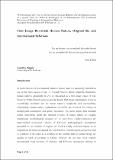Files in this item
First image revisited : human nature, original sin and international relations
Item metadata
| dc.contributor.author | Paipais, Vassilios | |
| dc.date.accessioned | 2017-09-20T23:32:00Z | |
| dc.date.available | 2017-09-20T23:32:00Z | |
| dc.date.issued | 2019-06-01 | |
| dc.identifier | 241247144 | |
| dc.identifier | c3443a15-76ae-4ce7-8d79-b412c6079380 | |
| dc.identifier | 85029602268 | |
| dc.identifier | 000467658500006 | |
| dc.identifier.citation | Paipais , V 2019 , ' First image revisited : human nature, original sin and international relations ' , Journal of International Relations and Development , vol. 22 , pp. 364-388 . https://doi.org/10.1057/s41268-016-0072-y | en |
| dc.identifier.issn | 1408-6980 | |
| dc.identifier.other | ORCID: /0000-0001-5564-3597/work/62311921 | |
| dc.identifier.uri | https://hdl.handle.net/10023/11704 | |
| dc.description.abstract | In Waltz’s famous classification, human nature’s propensity to evil is catalogued as a first-image causal explanation of war. Ever since, human nature explanations of conflict have been attacked for resting on metaphysical assumptions and a priori pessimism. This paper argues that modern conceptions about the inherent wickedness of human nature or, equally, reductionist sociobiological explanations about its hard-wired conflict-proneness are impoverished secularised versions of Christian anthropological assumptions grounded in the doctrine of original sin. Itself a widely contested dogma, in its Augustinian formulation it was closely connected with a soteriological perspective, that is, a defence of its status as a corollary of the doctrine that all human beings are equally in need of salvation in Jesus Christ. However, its use was never entirely disconnected from the purposes of theodicy and Christian apologetics striving to reconcile the existence of a benevolent and omnipotent God with the reality of evil and suffering in the world. It is this latter legacy – associated with the explanation of suffering and evil in the world but stripped of its salvific eschatological content – that is picked up by secularist theorisations of human nature which tend to reduce the paradox of original sin to the parody of man’s evil nature. | |
| dc.format.extent | 31 | |
| dc.format.extent | 354731 | |
| dc.language.iso | eng | |
| dc.relation.ispartof | Journal of International Relations and Development | en |
| dc.subject | Human nature | en |
| dc.subject | Original Sin | en |
| dc.subject | Augustine | en |
| dc.subject | Kant | en |
| dc.subject | Niebuhr | en |
| dc.subject | Sociobiology | en |
| dc.subject | B Philosophy (General) | en |
| dc.subject | BT Doctrinal Theology | en |
| dc.subject | JZ International relations | en |
| dc.subject | T-NDAS | en |
| dc.subject | BDC | en |
| dc.subject | R2C | en |
| dc.subject | SDG 16 - Peace, Justice and Strong Institutions | en |
| dc.subject.lcc | B1 | en |
| dc.subject.lcc | BT | en |
| dc.subject.lcc | JZ | en |
| dc.title | First image revisited : human nature, original sin and international relations | en |
| dc.type | Journal article | en |
| dc.contributor.institution | University of St Andrews. School of International Relations | en |
| dc.identifier.doi | 10.1057/s41268-016-0072-y | |
| dc.description.status | Peer reviewed | en |
| dc.date.embargoedUntil | 2017-09-20 |
This item appears in the following Collection(s)
Items in the St Andrews Research Repository are protected by copyright, with all rights reserved, unless otherwise indicated.

